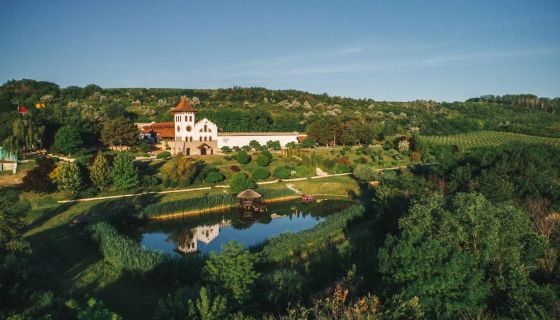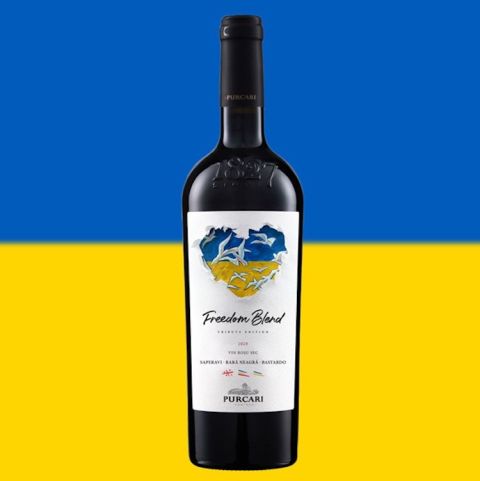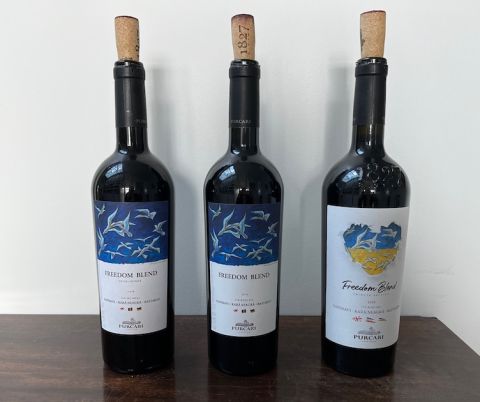From 38 Romanian lei, 190 Moldovan lei, 390 Ukrainian hryvnia, €15.71,198 Swedish kronor, $22.99, £19.99, 4,257 Japanese yen, SG$69
For all the worst reasons we hear a great deal about Ukraine at the moment. (Keep following our series of Letters from Kyiv sent regularly by one of Ukraine’s leading wine importers.)
But Moldova is just over Ukraine’s western border and it is no wonder that Moldovans feel a kinship with Ukrainians and are deeply concerned about any Russian advance. Wine production may seem almost frivolous in this geopolitical context but wine is hugely important to the Moldovan economy.
Specialist in Eastern European wine Caroline Gilby MW hosted a presentation of Moldovan wines in London last month which was pretty fascinating. I will be reporting in detail on it and the wines shown but there was one wine that particularly caught my attention and seems ever more topical and relevant.
In 2014, soon after the annexation of the Crimea, Chateau Purcari, the dominant Moldovan producer whose headquarters is shown above, launched a wine they called Freedom Blend. Based on the 2011 vintage, it was a red blend designed to celebrate 20 years of freedom from the Soviet Union. (Moldova became an independent republic in 1991.) But they also say in their description of the wine that it was also designed to be ‘an outcry against [Russian] military aggression: Transnistria in 1992, Abkhazia and South Ossetia in 2008, Crimea and Donbas in 2014’. Transnistria is a Russian-held enclave in the north-east of Moldova; Russia annexed Abkhazia and South Ossetia in the west of Georgia, just as it did to the Ukrainian territories of Crimea and Donbas, long before invading eastern Ukraine earlier this year.
The idea behind Freedom Blend is that it’s a clever blend of three varieties that represent each of these aggressed countries. Rară Neagră, identical to the Băbească Neagră of Romania, where it is not as highly valued as in Moldova, represents the country in which the wine is made. Saperavi is of course a Georgian grape and has shown particular promise when grown in Moldova. And the variety chosen to represent Ukraine is the Ukrainian cross of Trousseau (aka Bastardo) x Saperavi called Bastardo Magarachsky, which takes its name from the Magarach institute in Crimea, where it was bred in 1949.
Not that much of this Ukrainian variety is grown in Moldova so it is the least significant ingredient with about 15% of the blend in most vintages. (Purcari have continued to produce the wine each year since 2014.) Nor is Rară Neagră widely planted, even in Moldova where it is revered, so that constitutes just 20%. The most significant ingredient, comprising 65% of the blend, is the highly successful Saperavi from Georgia, which has flourished in Moldova ever since the late 19th century (when Moldova was part of the Russian Empire) and arrived at about the same time as Cabernet Sauvignon, which is the most common grape variety in Moldova today.
The relative rarity of Rară Neagră and, especially, Bastardo Magarachsky means that it can be quite challenging to put the blend together, but Purcari are determined that all three countries should be represented in this highly political wine. All profits from the sale of Freedom Blend are donated to the Ukrainian war effort, and because of Chateau Purcari’s location just a few kilometres from the Ukrainian border, the winery has been offering help and accommodation to many a Ukrainian refugee.
The Saperavi and Rară Neagră grapes are grown in the same region as the winery, in Stefan Voda in the south-east of Moldova, where the vineyards benefit from the influence of the Black Sea about 50 km to the south. The Bastardo Magarachsky grapes are grown in the hotter Valul lui Traian region in the south of the country but the Freedom Road harvest doesn’t take place until late October when the grapes are hand-picked into small plastic crates. In the winery, fermentation in tank lasts about two weeks at 28–30 °C before six months’ ageing in new French oak barriques from Seguin Moreau. It’s a wonder this doesn’t cost more really.
The 2020 vintage was shown at Gilby’s masterclass and I really enjoyed it. It’s 13.5% alcohol with 3.3 g/l residual sugar and 5.4 g/l total acidity. My tasting note:
Full embossed bottle 1,410 g. Lively crimson. Round fruit, and richer than the pure Saperavi tasted beforehand. Very nice blend with a real future although it’s already approachable with lots of life. There’s a rather attractive hint of treacle and great balance. A fascinating, distinctive wine with rather better tannin management than in the 2019. 16.5 Drink 2022–27
My only caveat is the weight of the 2020 bottle. I took the Purcari team at the London tasting to task about this and they swear they are mending their ways. They may be forced to with such a shortage of bottles in their part of the world.
I was subsequently sent earlier vintages which are in commercial circulation and they are in much lighter bottles which still look very smart as you can see in the image below, with its additional Ukrainian influence for the 2020.
2019 14.5%
Full bottle 1,223 g. Mid to deep garnet. Satisfying broad, nicely developed, ripe nose with a good interplay between the potential severity of Saperavi and real richness. At peak now, I'd say, although there is still a bit of tannin lurking in the background. Long finish. Nothing industrial about this. Does this reflect the clean air of the Moldovan countryside, where agrochemicals are rare? Best enjoyed with food. 16.5 Drink 2020–25
2018 14%
Full bottle 1,255 g. Mid to dark garnet. Less assertive nose than the 2019 but arguably subtler. Vigorous, lively, very honest fruit but just a little heavy on the tannins – too-aggressive extraction? But the sweet blackberry fruit is agreeably ripe with just the right amount of acidity. A hint of smokiness on the finish, which is a bit shorter than that of the 2019. 16 Drink 2022–25
For such an unusual wine, Freedom Blend is surprisingly widely distributed – a sign of solidarity with the Ukrainian people perhaps? According to Wine-Searcher.com, the 2020 is available in Romania, Moldova, the Netherlands, US, Japan and Singapore. The 2019 is in Romania, Moldova, Sweden, Austria and the UK (from Novel Wines of Somerset). The 2018 is in Romania while the 2017 is in the US and Austria, and the 2016, which may be a bit long in the tooth, is in Bulgaria.
See all 10 of our articles about Moldova.















